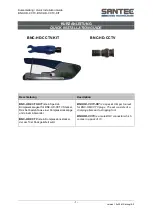
9
•
Do not cut into areas which may contain electrical wiring or piping. This tool is not insulated against electric shock,
contact with a live wire will make exposed metal parts live.
•
Accessories and tools can get hot during operation. Wear gloves when touching them.
•
Keep bystanders a safe distance away from work area. Anyone entering the work area must wear personal protective
equipment. Fragments of workpiece or of a broken accessory may fly away and cause injury beyond immediate area
of operation.
•
Never direct air at yourself or anyone else.
•
Wear warm clothing whenever working in cold conditions and keep your hands warm and dry.
•
Whipping hoses can cause severe injury. Always check for damaged or loose hoses and fittings.
•
Avoid prolonged contact with dust from power sanding, sawing, grinding, drilling, chipping and other construction
activities. Wear protective clothing and wash exposed areas with soap and water. Allowing dust to get into your mouth,
eyes, or lay on the skin may promote absorption of harmful chemicals.
•
Store idle power tools out of the reach of children and do not allow persons unfamiliar with the power tool or these
instructions to operate the power tool. Power tools are dangerous in the hands of untrained users.
•
Do not let children come in contact with this tool. Supervision is required when inexperienced operators use this tool.
•
Do not modify this tool. Modifications can reduce the effectiveness of safety measures and increase the risks to the
operator.
•
Do not discard the safety instructions; give them to the operator.
•
Do not use the tool if it has been damaged.
•
Be aware that the failure of the workpiece or accessories, or even of the tool itself, can generate high-velocity
projectiles.
•
This product is not intended for use by persons (including children) suffering from diminished physical, sensory or
mental abilities; lack of experience, knowledge or skills unless they are supervised by person responsible for their
safety. Children should never be left alone whith this product. This tool and its accessories must be used in
compliance with these instructions. Using it for any other purpose may cause a risk of danger for people and the
environment.
•
Only qualified and trained operators should install, adjust or use the tool.
•
For overhead work, wear a safety helmet.
•
Sparks from cutting can ignite clothing and cause severe burns. Ensure sparks do not land on clothing. Wear fire-
retardant clothing and have a bucket of water nearby.
•
Direct the exhaust so as to minimize disturbance of dust in a dust-filled environment.
•
Where dust or fumes are created, the priority shall be to control them at the point of emission.
•
All integral features or accessories for the collection, extraction or suppression of airborne dust or fumes should be
correctly used and maintained in accordance with the manufacturer’s instructions.
•
Select, maintain and replace the consumable/inserted tool as recommended in the instructions, to prevent an
unnecessary increase in dust or fumes.
1 - POWER TOOL USE AND CARE
•
Before running the tool, check that there is no dangerous interaction with the immediate environment (explosive gas, flammable
or dangerous liquid, unknown piping, electric sheathing or cable, etc).
•
Before connecting the tool to the air inlet, check the trigger is not blocked in the on position by an obstacle.
•
In the event of blockage, release the trigger and disconnect the tool from the compressed air network.
•
Ensure that the unit on which work is being carried out is immobilized.
•
Always operate, inspect and maintain this tool in accordance with all regulations (local, state, federal and country), that may apply
to hand held/hand operated pneumatic tool.
•
For safety, top performance, and maximum durability of parts, operate this tool at 90 psig. (6.2 bar / 620 kPa) maximum air
pressure at the inlet with 3/8’’ (10mm) inside diameter air supply hose.
•
Always use clean, dry air. Dust, corrosive fumes and/or excessive moisture can ruin the motor of an air tool.
•
Exceeding the maximum pressure of 90 psig (6.2 bar / 620 kPa) will lead to the risk of danger such as excessive speed, tool wear,
breaking parts, higher torque or force that may destroy the tool and its accessories or the part being worked on.
•
Maintain power tools. Check for misalignment or binding of moving parts, breakage of parts and any other condition that may
affect the power tool’s operation. If damaged, have the power tool repaired before use. Many accidents are caused by poorly
maintained power tools.
•
Keep cutting tools sharp and clean. Properly maintained cutting tools with sharp cutting edges are less likely to bind and are
easier to control.
•
Use rated accessories recommended by FACOM only. Inspect accessories before use. Do not use cracked or damaged
accessories. Just because the accessory can be attached to your power tool, it does not assure safe operation.
•
Use the power tool, accessories and tool bits, etc. in accordance with these instructions, taking into account the working
conditions and the work to be performed. Use of the power tool for operations different from those intended could result in a
hazardous situation.
•
For multiple hazards, read and understand the safety instructions before installing, operating, repairing, maintaining, changing
accessories on, or working near the saw. Failure to do so can result in serious bodily injury.
•
Ensure that sparks and debris resulting from use do not create a hazard.
•
The pneumatic tool must be fitted and connected to the compressed air network via quick disconnects to facilitate shutdown in
the event of danger.
•
When the life of the tool has expired, it is recommended that the tool be disassembled, degreased and parts be separated by
material so that they can be recycled.
NU-V.330FH-V.335FH_0317.indd 9
15/03/2017 09:38:31










































